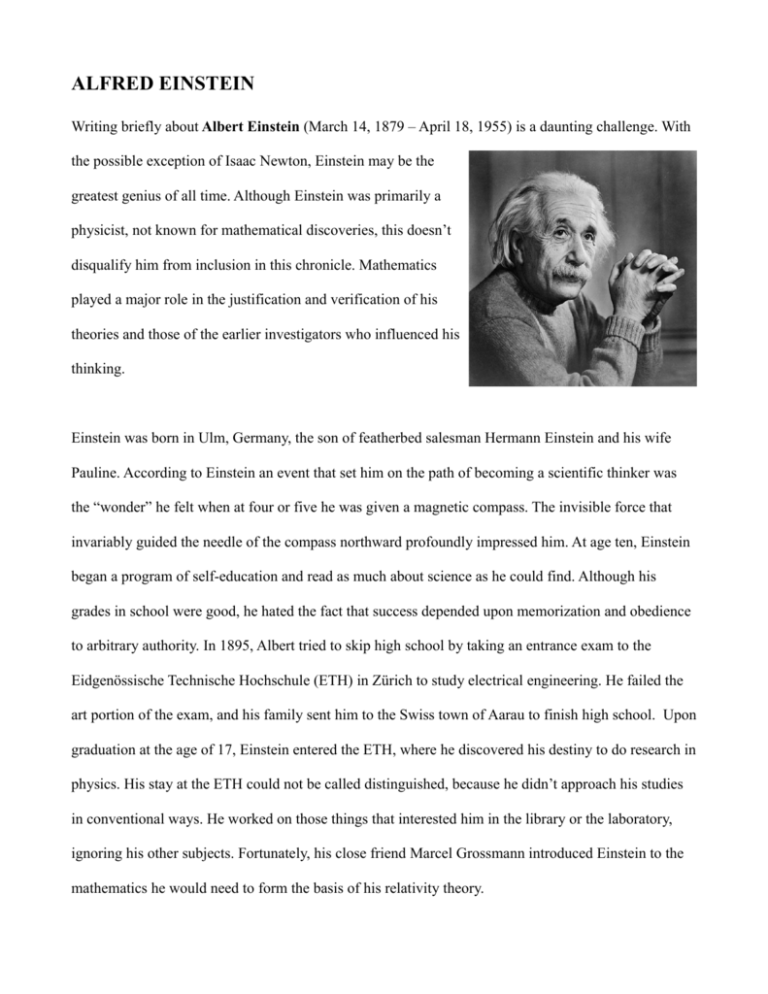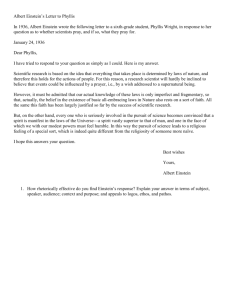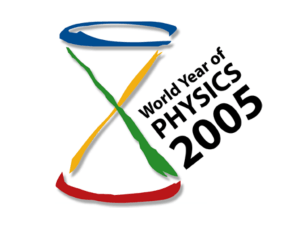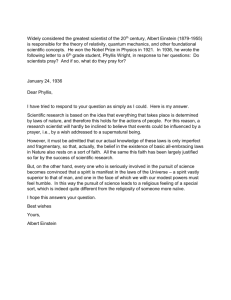Einstein, Alber - A Chronicle of Mathematical People by Robert A
advertisement

ALFRED EINSTEIN Writing briefly about Albert Einstein (March 14, 1879 – April 18, 1955) is a daunting challenge. With the possible exception of Isaac Newton, Einstein may be the greatest genius of all time. Although Einstein was primarily a physicist, not known for mathematical discoveries, this doesn’t disqualify him from inclusion in this chronicle. Mathematics played a major role in the justification and verification of his theories and those of the earlier investigators who influenced his thinking. Einstein was born in Ulm, Germany, the son of featherbed salesman Hermann Einstein and his wife Pauline. According to Einstein an event that set him on the path of becoming a scientific thinker was the “wonder” he felt when at four or five he was given a magnetic compass. The invisible force that invariably guided the needle of the compass northward profoundly impressed him. At age ten, Einstein began a program of self-education and read as much about science as he could find. Although his grades in school were good, he hated the fact that success depended upon memorization and obedience to arbitrary authority. In 1895, Albert tried to skip high school by taking an entrance exam to the Eidgenössische Technische Hochschule (ETH) in Zürich to study electrical engineering. He failed the art portion of the exam, and his family sent him to the Swiss town of Aarau to finish high school. Upon graduation at the age of 17, Einstein entered the ETH, where he discovered his destiny to do research in physics. His stay at the ETH could not be called distinguished, because he didn’t approach his studies in conventional ways. He worked on those things that interested him in the library or the laboratory, ignoring his other subjects. Fortunately, his close friend Marcel Grossmann introduced Einstein to the mathematics he would need to form the basis of his relativity theory. Einstein renounced his German citizenship in 1896 and remained stateless until he became a Swiss citizen in 1901. After graduating in 1900, Einstein was unsuccessful in securing a position teaching mathematics and physics in universities, so he took temporary jobs teaching mathematics in high schools. The next year he secured employment with the patent office in Bern. In 1905, he earned a doctorate from the University of Zürich for a thesis entitled, On a new determination of molecular dimensions. That same year, while holding down a forty-hour a week job at the patent office, Einstein gave the world his Special Theory of Relativity when he submitted his paper “On the Electrodynamics of Moving Bodies” to Annalen de Physik. The theory stemmed from his attempt to reconcile the laws of mechanics with the laws of the electromagnetic field. Aware of the inadequacies of Newtonian mechanics, Einstein wrote several papers applying the special theory of relativity to mass and energy. In September of 1905 he reported a remarkable consequence of his theory, namely that if a body emits a certain amount of energy, then the mass of that body must decrease by a proportionate amount. The relationship is expressed as the equation E = MC2 (The energy content of a body is equal to the mass of the body times the speed of light squared.). He had developed an explanation of the fundamental problems about the nature of energy, matter, motion, time, and space. Had he done nothing more, Einstein’s reputation would have been established, but for the next twenty years he was always on the cutting edge of physics, making even 1905, his “Annus Mirabilis” (Miracle Year) seem almost ordinary by comparison. In 1907, as others explored the implications of his special theory of relativity, Einstein was mulling over a more general theory. He turned his attention to the problem of gravitation – the same problem that Newton almost solved – by considering the invariance of the acceleration (in the absence of air resistance) of two bodies, however different, falling to the ground from the same height. This discovery of Galileo, known to Newton, was the starting point of a new theory. In 1908 Einstein declared that resolving the issue of quantum mechanics is the central problem of physics. The next year, with the assistance of Grossmann, Einstein began work on the general theory of relativity, publishing a definitive version of it in 1915. He showed that matter and energy actually mold the shape of space and the flow of time. Feeling the “force” of gravity is simply the sensation of following the shortest possible path through curved four-dimensional space. In 1908, Einstein became a lecturer at the University of Bern and the following year he was appointed a physics professor at the University of Zürich. By this time, Einstein was recognized as one of the leading scientific-thinkers of the period. In 1911, he was appointed a full professor at the KarlFerdinand University in Prague. From 1914, Einstein held a chair at the University of Berlin and was the director of the Kaiser Wilhelm Institute of Physics in Berlin. Throughout the 1920s and early 1930s, Einstein made numerous international visits, both as a spokesman for liberal causes and as an esteemed member of the scientific community, showered with honors at every stop. During this period his lectures were interrupted by Nazi demonstrations that were clearly anti-Jewish. As the Nazi movement grew stronger, Einstein helped organize a non-partisan group within the Jewish community that advocated a united stand against fascism. In 1932 he accepted a post as Professor of Theoretical Physics at Princeton University in the United States. He left Berlin just five months before the Nazis came to power, never to return to Germany. His property was confiscated, and his name appeared on the first list of those stripped of their citizenship. Einstein was granted permanent residence in the United States in 1935, and, in 1940, he became a citizen of the U.S., while maintaining his Swiss citizenship. In 1939 Einstein wrote a letter to President Franklin D. Roosevelt warning of the possibility of Germany’s building an atomic bomb and urged that the United States take up nuclear research. Einstein married fellow student Mileva Marić in 1903. The couple had a daughter who was given up for adoption before they married, followed by two sons, Hans Albert (1904), who had a distinguished career on the faculty of the University of California, and Eduard (1910), who later had a mental breakdown. At the outbreak of WWI Einstein was in Berlin while his family was in Switzerland. He complained he was “starved for love” and felt trapped in an increasingly strained and gloomy relation with Mileva. He had a love affair with his first cousin Elsa Löwenthal. Albert and Mileva separated in 1914 and after bitter arguments divorced in 1919. Mileva was a gifted physicist in her own right. She and Einstein worked together on the mathematics of his theoretical thinking. In recognition of her contribution he gave her the money he received for his Nobel Prize. Einstein married Elsa, who had two grown daughters by a previous marriage. She died in 1936, leaving the care of Einstein’s Princeton home in the hands of one of her daughters and Einstein’s long-time secretary. The year of their marriage, 1919, Einstein became a celebrity thanks to a solar eclipse during which an experiment confirmed that light rays from distance stars were deflected by the gravity of the Sun in just the amount he had predicted in his theory of gravity. Einstein spent most of the latter part of his life searching for a deeper theory to subsume quantum mechanics and eliminate its probabilities and uncertainties. He was positive that one day someone would do so but he was unsuccessful. He proposed several unified theories in various mathematical forms, but each contained flaws, most of which he discovered himself. Undeterred he turned to new formulations, unsuccessfully searching for a theory that would explain the structure of matter. In 1952 he was offered the, mostly honorary, post of president of Israel but declined. Instead he collaborated with Dr. Chaim Weizmann in establishing the Hebrew University of Jerusalem to which Einstein contributed his scientific papers. Always a champion of international peace, a week before his death in 1955, he wrote to Bertrand Russell to add his name to a manifesto urging all nations to ban nuclear weapons. What Einstein did better than perhaps anyone since Isaac Newton was “think.” He recognized a problem, was determined to solve it, and set about doing so by some deep and difficult thinking. There are theories that no human beings make the most of their potential for thinking, but those who are recognized as geniuses use much more than ordinary people. Most individuals can make greater use of their ability to think than they actually do. To accomplish this one must practice, practice, practice. It requires time be set aside for doing nothing but thinking in some place where one will not be disturbed or distracted. The anecdotes about geniuses that have given rise to the jokes about absent-minded professors are many and amusing, but such individuals are not absent-minded, they are mind-occupied with thoughts that leave no room for mundane things. Let them think without ridicule. They are probably going to make momentous discoveries and inventions that will benefit us all. Quotation of the Day: “I want to know how God created this world. I am not interested in this or that phenomenon, in the spectrum of this or that element. I want to know His thoughts; the rest are details.” – Albert Einstein






